Family Name: Acanthaceae A.L. Jussieu
Synonym(s): Avicenniaceae Miq., nom. cons.; Justiciaceae Raf.; Mendonciaceae Bremek.; Meyeniaceae Sreem.; Nelsoniaceae Sreem.; Thunbergiaceae Lilja
Common Name(s): acanthus family
*Number of genera/species: 210/4,000
List of genera records in GRIN-Global
Fruit a bilocularbilocular:
(ovary or fruit) having two locules
, loculicidalloculicidal:
type of capsular dehiscence, opening longitudinally through the locules (compare septicidal)
 capsulecapsule:
capsulecapsule:
a dry, dehiscent fruit derived from a compound ovary , usually elastically dehiscentdehiscent:
, usually elastically dehiscentdehiscent:
(v. dehisce) splitting open at maturity to release contents (of a fruit) from apexapex:
from apexapex:
the point farthest from the point of attachment, or the "tip" of an organ downwards, rarely a drupedrupe:
downwards, rarely a drupedrupe:
(indehiscent drupe) a fleshy, indehiscent fruit with one more hard pits enclosing seeds, derived from single, superior, simple or compound ovary; (dehiscent drupe) a fruit with a dry or fibrous to fleshy or leathery outer husk that early to tardily breaks apart (or opens), exposing one or more nutlike pits enclosing the seeds , 1–50 mm, usually clavateclavate:
, 1–50 mm, usually clavateclavate:
3D shape—club-shaped, with attachment at or near narrow end (compare obclavate) , ovoidovoid:
, ovoidovoid:
3D shape—ovate , or linearlinear:
, or linearlinear:
(shape) long, narrow, and uniform in width; (of embryo) embryo is straight and much longer than wide , stipitatestipitate:
, stipitatestipitate:
borne on a stalk
or not, tereteterete:
approximately circular in cross section; width and thickness approximately equal
 or compressedcompressed:
or compressedcompressed:
flattened; in grasses, used to denote compression (not necessarily flattened) either laterally or dorsiventrally
in transection, sometimes beakedbeak:
a usually firm, terminal appendage, sometimes tapered , usually with 2–4 seeds, sometimes up to 60 seeds (Nelsonioideae), rarely one seed (Avicennia), calyxcalyx:
, usually with 2–4 seeds, sometimes up to 60 seeds (Nelsonioideae), rarely one seed (Avicennia), calyxcalyx:
the outer whorl of the perianth; all the sepals of a flower persistent. Pericarppericarp:
persistent. Pericarppericarp:
fruit wall or fruit coat
usually brown, sometimes black or yellow, rarely green (Avicennia), shinyshiny:
uniformly reflecting a high proportion of incident light at all angles or dulldull:
or dulldull:
reflecting only a low proportion of incident light, with no apparent sheen , thin or thick-walled, leatheryleathery:
, thin or thick-walled, leatheryleathery:
texture—moderately thick, tough, and very pliable
or woodywoody:
texture—consisting mainly of indurate lignified tissues, characteristic of or resembling wood
(capsulecapsule:
a dry, dehiscent fruit derived from a compound ovary ) or fleshy (drupedrupe:
) or fleshy (drupedrupe:
(indehiscent drupe) a fleshy, indehiscent fruit with one more hard pits enclosing seeds, derived from single, superior, simple or compound ovary; (dehiscent drupe) a fruit with a dry or fibrous to fleshy or leathery outer husk that early to tardily breaks apart (or opens), exposing one or more nutlike pits enclosing the seeds ), glabrousglabrous:
), glabrousglabrous:
without hairs
, pubescentpubescent:
surface relief—bearing hairs
sometimes glandularglandular:
surface relief—covered with small, raised secretory glands, regular or irregularly shaped, translucent or opaque, and maybe distinctly colored , usually smooth. CapsulesCapsule:
, usually smooth. CapsulesCapsule:
a dry, dehiscent fruit derived from a compound ovary in Acanthoideae (which makes up 90% of the family) with distinctive, persistent seed bearing hookswith hooks:
in Acanthoideae (which makes up 90% of the family) with distinctive, persistent seed bearing hookswith hooks:
bristles or spines with curved or backwards pointing tips, or with secondary bristles along their length or retinacula formed from the funiculifuniculus:
or retinacula formed from the funiculifuniculus:
(alt. funicle) stalk connecting the ovule (later seed) to the ovary (later fruit) placenta . At dehiscence, septaseptum:
. At dehiscence, septaseptum:
(pl. septa) a dividing cross wall or partition
 or placentaplacenta:
or placentaplacenta:
surface of the ovary that bears ovules
with retinacula often separating from the inner wall. Retinacula absent in Avicennioideae, Nelsonioideae, and Thunbergioideae, although Nelsonioideae with papilliform or elongate, not persistent, funiculifuniculus:
(alt. funicle) stalk connecting the ovule (later seed) to the ovary (later fruit) placenta .
.
Seeds usually discoiddiscoid:
3D shape—resembling a disc
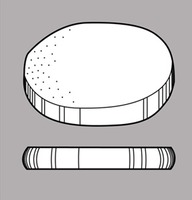 , flattened in transection, rarely tereteterete:
, flattened in transection, rarely tereteterete:
approximately circular in cross section; width and thickness approximately equal
 , bowl-like in Thunbergia, 0.3–10 mm (to 30 mm, Avicennia). Rarely winged, if present, one wing encompassing seed or at one end. Seeds usually brown, dulldull:
, bowl-like in Thunbergia, 0.3–10 mm (to 30 mm, Avicennia). Rarely winged, if present, one wing encompassing seed or at one end. Seeds usually brown, dulldull:
reflecting only a low proportion of incident light, with no apparent sheen , sometimes shinyshiny:
, sometimes shinyshiny:
uniformly reflecting a high proportion of incident light at all angles , usually sculptured, sometimes smooth, with hygroscopic hairs covering seeds or just along margins, often becoming mucilaginousmucilaginous:
, usually sculptured, sometimes smooth, with hygroscopic hairs covering seeds or just along margins, often becoming mucilaginousmucilaginous:
resembling mucilage; moist and sticky
when wetted. In Avicennia, seeds are large, green, fleshy, and germinate on the plants.
Embryo well developed, nearly completely filling seed cavity, axil and centric, foliatefoliate:
appearing leaf-like
, straight or slight curvedcurved:
(of embryo) linear embryo is curved into an arch or horseshoe with the ends far apart , with spatulatespatulate:
, with spatulatespatulate:
2D shape—like a spatula; rounded at the apex, with base long and tapered; (of embryo) embryo is straight and axile and centric with the cotyledons expanded to form the shape of a spatula or spoon; (of cotyledons) cotyledons expanded and wider than the stalk but not invested into the stalk cotyledons.
cotyledons.
Endosperm usually scanty, moderate and persistent in Nelsonioideae.
Noxious Weed: USA Federal Noxious Weed List, aquatic, Hygrophila polysperma (Roxb.) T. Anderson.
Federal Noxious Weed Disseminules of the US tool provides a description and image of this species. Aquarium & Pond Plants of the World tool also includes descriptions and images of this and other species in this family, which may be encountered.
| Fruit | |
| Type | capsulecapsule: a dry, dehiscent fruit derived from a compound ovary  , rarely drupedrupe: , rarely drupedrupe:(indehiscent drupe) a fleshy, indehiscent fruit with one more hard pits enclosing seeds, derived from single, superior, simple or compound ovary; (dehiscent drupe) a fruit with a dry or fibrous to fleshy or leathery outer husk that early to tardily breaks apart (or opens), exposing one or more nutlike pits enclosing the seeds  |
| Size range | 1–50 mm long |
| Shape(s) | subglobosesubglobose: 3D shape—almost globose , clavateclavate: 3D shape—club-shaped, with attachment at or near narrow end (compare obclavate)  , ellipsoidellipsoid: , ellipsoidellipsoid:3D shape—elliptic , fusiformfusiform: spindle-shaped; broadest at the middle and tapering at both ends  , obovoidobovoid: , obovoidobovoid:3D shape—obovate , conicalconical: 3D shape—cone-shaped, with the point of attachment at the broad end 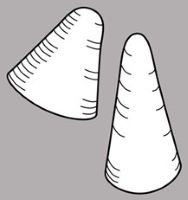 , linearlinear: , linearlinear:(shape) long, narrow, and uniform in width; (of embryo) embryo is straight and much longer than wide  , oblongoblong: , oblongoblong:2D shape—much longer than broad with nearly parallel sides, corners are rounded  , cylindricalcylindrical: , cylindricalcylindrical:3D shape—a cylinder, with parallel sides and a circular cross-section; tubular or rod-shaped , rarely angledangular: 2D shape—having sides that meet at acute or obtuse angles or pear-shaped |
| Texture | leathery, woodywoody: texture—consisting mainly of indurate lignified tissues, characteristic of or resembling wood (capsulecapsule: a dry, dehiscent fruit derived from a compound ovary  ), fleshy (drupedrupe: ), fleshy (drupedrupe:(indehiscent drupe) a fleshy, indehiscent fruit with one more hard pits enclosing seeds, derived from single, superior, simple or compound ovary; (dehiscent drupe) a fruit with a dry or fibrous to fleshy or leathery outer husk that early to tardily breaks apart (or opens), exposing one or more nutlike pits enclosing the seeds  ) ) |
| Surface relief | smooth |
| Color(s) | usually brown, sometimes black or yellow, rarely green (Avicennia) |
| Unique features | Usually leathery or woodywoody: texture—consisting mainly of indurate lignified tissues, characteristic of or resembling wood , brown, bilocularbilocular: (ovary or fruit) having two locules capsules with explosive dehiscence and distinctive seed bearing hookswith hooks: bristles or spines with curved or backwards pointing tips, or with secondary bristles along their length  . CapsulesCapsule: . CapsulesCapsule:a dry, dehiscent fruit derived from a compound ovary  often stipitatestipitate: often stipitatestipitate:borne on a stalk . |
| Seed | |
| Size range | 0.3–10 mm (to 30 mm, Avicennia) |
| Shape(s) | discoiddiscoid: 3D shape—resembling a disc  , lenticularlenticular: , lenticularlenticular:3D shape—lens-shaped; biconvex  , plano-convexplano-convex: , plano-convexplano-convex:2D or 3D shape—flat on one side, convex on the other 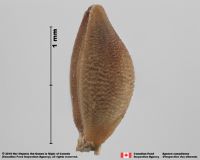 , circularcircular: , circularcircular:(of embryo) linear embryo is curved into an "O" shape  , ellipticelliptic: , ellipticelliptic:2D shape—oval, oblong-like with the 2 ends narrowing and more or less alike 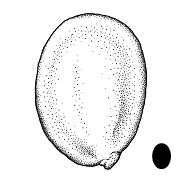 , ovateovate: , ovateovate:2D shape—egg-shaped in outline, widest point is towards one end of the organ, the other end tapers gradually, attachment at or near the broad end (compare obovate, ovoid)  in outline, rarely reniformreniform: in outline, rarely reniformreniform:2D or 3D shape—kidney-shaped  , obcordateobcordate: , obcordateobcordate:2D shape—heart-shaped, with attachment at or near the narrow end (compare cordate) 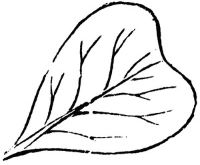 , triangulartriangular: , triangulartriangular:2D shape—three relatively straight sides with distinct corners; more angular than teardrop-shaped  , blocky , blocky |
| Surface relief | alveolate, rugulose, tuberculatetuberculate: surface relief—bearing small, warty, swelling, rounded, or variously shaped projections  , papillate, sometimes with spines or glochidiate, often with appressedappressed: , papillate, sometimes with spines or glochidiate, often with appressedappressed:pressed close to or lying flat against something, as in hairs on grass bract hairs on both surfaces or just along margins, rarely smooth |
| Color(s) | black, brown, reddish brown, yellow, rarely white |
| Unique features | Usually small, flattened, discoiddiscoid: 3D shape—resembling a disc  , sculptured seeds, often pubescent with hygroscopic hairs becoming mucilaginousmucilaginous: , sculptured seeds, often pubescent with hygroscopic hairs becoming mucilaginousmucilaginous:resembling mucilage; moist and sticky when wetted. In Avicennia, seeds are large, green, fleshy, and germinate on the plant. |
| Other | |
| Embryo | well developed, nearly filling seed cavity, axil and centric, foliatefoliate: appearing leaf-like , straight or slight curvedcurved: (of embryo) linear embryo is curved into an arch or horseshoe with the ends far apart  , with spatulatespatulate: , with spatulatespatulate:2D shape—like a spatula; rounded at the apex, with base long and tapered; (of embryo) embryo is straight and axile and centric with the cotyledons expanded to form the shape of a spatula or spoon; (of cotyledons) cotyledons expanded and wider than the stalk but not invested into the stalk  cotyledons cotyledons |
| Nutritive tissue | endosperm usually scanty, moderate and persistent in Nelsonioideae |
Worldwide, mainly tropical regions
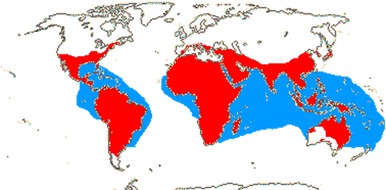
Distribution map courtesy of Angiosperm Phylogeny Website.
Daniel 2016Daniel 2016:
Daniel T. 2016. Vascular Plants of Arizona: Acanthaceae, Acanthus or Shrimp-plant Family. Canotia 12:22–54.; Daniel and McDade 2014Daniel and McDade 2014:
Daniel TF and McDade LA. 2014. Nelsonioideae (Lamiales: Acanthaceae): Revision of Genera and Catalog of Species. Aliso: A Journal of Systematic and Floristic Botany 32: 1–45. https://scholarship.claremont.edu/aliso/vol32/iss1/2:; Durkee 2013Durkee 2013:
Durkee LH. 2013. Acanthaceae. Flora of Panama (WFO). Missouri Botanical Garden. Accessed April 2024. URL: http://legacy.tropicos.org/Name/42000303?projectid=56; Burgos-Hernández and Castillo-Campos 2020Burgos-Hernández and Castillo-Campos 2020:
Burgos-Hernández M and Castillo-Campos G. 2020. Taxonomic revision of the Mesoamerican genus Spathacanthus (Justicieae, Acanthoideae, Acanthaceae). PhytoKeys 144: 31–55. https://doi.org/10.3897/phytokeys.144.46929; Flora of Australia 2021+Flora of Australia 2021+:
Flora of Australia. Australian Biological Resources Study, Canberra. Accessed January 2021–March 2024. URL: http://www.ausflora.org.au; Graham 1988Graham 1988:
Graham VAW. 1988. Delimitation and Infra-Generic Classification of Justicia (Acanthaceae). Kew Bulletin 43: 551–624. https://doi.org/10.2307/4129957; Hutchinson and Dalziel 1954–1972Hutchinson and Dalziel 1954–1972:
Hutchinson J and Dalziel JM, revised by Keay RWJ and Hepper FN. 1954–1972. Flora of West Tropical Africa, ed. 2, 3 Vols. 2300 pp.; Kiel et al. 2017Kiel et al. 2017:
Kiel CA, McDade LA, Daniel TF, and Champluvier D. 2017. Phylogenetic delimitation of Isoglossinae (Acanthaceae: Justicieae) and relationships among constituent genera. Taxon 55: 683–694.; Kirkbride et al. 2006Kirkbride et al. 2006:
Kirkbride JH, Jr, Gunn CR, and Dallwitz MJ. 2006. Family guide for fruits and seeds, vers. 1.0. Accessed September 2020-January 2022. URL: https://nt.ars-grin.gov/seedsfruits/keys/frsdfam/index.cfm .; Llamozas 1993Llamozas 1993:
Llamozas S S. 1993. Sinopsis del genero Aphelandra R. Br. (Acanthaceae) en Venezeula. Acta Botánica Venezuélica 16(2/4): 29–53. http://www.jstor.org/stable/41740498; Manzitto-Tripp et al. 2022Manzitto-Tripp et al. 2022:
Manzitto-Tripp EA, Darbyshire I, Daniel TF, Kiel CA, and McDade LA. 2022. Revised classification of Acanthaceae and worldwide dichotomous keys. TAXON 71: 103–153. https://doi.org/10.1002/tax.12600; Mota de Oliveira 2024Mota de Oliveira 2024:
Mota de Oliveira S. 2024. Original Flora of the Guianas. Conversion to Drupal by Thomas Hamann. Accessed April 2024. URL: https://portal.cybertaxonomy.org/flora-guianas/; Takhtajan 2009Takhtajan 2009:
Takhtajan A. 2009. Flowering plants: Second edition. Springer Nature, Switzerland. 871 pp.; Tropicos.org 2021+Tropicos.org 2021+:
Tropicos.org. 2021+. Pakistan Plant Database. Missouri Botanical Garden. Accessed January 2021–April 2024. http://legacy.tropicos.org/Project/Pakistan; Tutin et al. 1964–1980Tutin et al. 1964–1980:
Tutin TG, Burges NA, Chater AO, Edmondson JR, Heywood VH, Moore DM, Valentine DH, Walters SM, and Webb DA (eds.) 1964–1980. Flora Europaea. 5 vols. Cambridge University Press, Cambridge UK. 2,524 pp.; Zhengyi et al. 2004+Zhengyi et al. 2004+:
Zhengyi W, Raven PH, and Deyuan H. 2004+. Flora of China [online]. 25 vols. Science Press, Beijing China & Missouri Botanical Garden, St. Louis USA. Accessed January–March 2024. http://flora.huh.harvard.edu/china/
*The number of genera and species is based on Christenhusz and Byng 2016Christenhusz and Byng 2016:
Christenhusz MJM and Byng JW. 2016. The number of known plant species in the world and its annual increase. Phytotaxa 261 (3): 201-217. https://doi.org/10.11646/phytotaxa.261.3.1, which may differ from the number of genera in GRIN-Global.